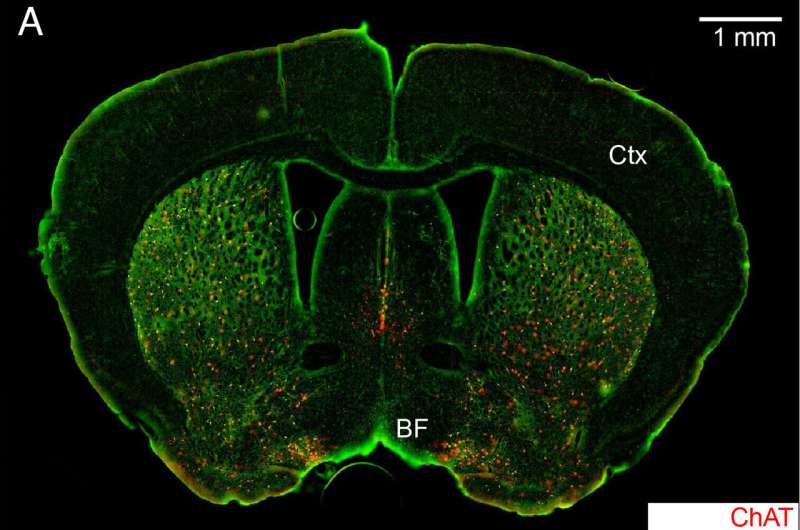This article has been reviewed according to Science X's editorial process and policies. Editors have highlighted the following attributes while ensuring the content's credibility:
fact-checked
peer-reviewed publication
trusted source
proofread
Combination of neurotransmitters regulates attention span, shows study

A team of researchers from Nanyang Technological University, Singapore (NTU Singapore) has uncovered new clues about how chemicals released by brain cells regulate our attention span.
Findings from the study could pave the way for new therapies to treat neurological conditions associated with concentration difficulties, such as depression and attention-deficit hyperactivity disorder (ADHD).
To communicate with one another, neurons in the brain and nervous system release chemicals called neurotransmitters that relay messages from one cell to another. Neurotransmitters are crucial for brain function and regulating all bodily functions, ranging from breathing and heart rate to reproduction.
These chemicals also coordinate cognitive processes that enable us to focus on important information within the constant barrage of stimuli the brain receives from the external environment, otherwise known as our attention span.
Researchers have long thought that our attention span was directed by only one neurotransmitter, acetylcholine, which excites neurons and causes them to fire electrical signals. However, recent work suggests that attention could require another neurotransmitter, gamma-aminobutyric acid (GABA), which inhibits neurons from receiving and sending messages.
In their study published in the Proceedings of the National Academy of Sciences, the team demonstrated for the first time that GABA works together with acetylcholine in a precise sequence to regulate the transmission of signals from a part of the brain's information processing network, called the claustrum.
Hidden deep in the brain, the claustrum is a thin sheet-like structure that receives and processes information from different parts of it. The claustrum helps to regulate concentration, but its exact role remains unknown.
Neurotransmitters toggle 'like a switch' to relay information
In lab experiments, the NTU scientists investigated how neurons in the claustrum in mice respond to acetylcholine and GABA produced by a part of the brain called the forebrain, that plays a central role in several brain functions.
The key technological advance that allowed the researchers to make this discovery is called optogenetics. Optogenetics uses light-sensitive proteins to selectively control the activity of specific types of neurons within the brain. In this case, the neurons within the forebrain that release acetylcholine and GABA were activated by light, allowing the team to measure the response of the claustrum to such a stimulus.
They discovered that two types of neurons in the claustrum, which send output signals to different parts of the brain, respond in opposing ways to acetylcholine and GABA. Neurons that extend to structures deep in the brain were excited by acetylcholine while neurons that extend to structures on the surface of the brain were inhibited by GABA.
Through this coordinated sequence of opposing actions, the two neurotransmitters toggle the transfer of information between the claustrum and the rest of the brain, like a switch. The study provides evidence that the neurotransmitters regulate a "microcircuit" in the brain, that allows the organ to differentiate important information from noise, helping a person pay attention.
The opposing actions of the neurotransmitters (acetylcholine and GABA) on neurons in the claustrum enable brain signals to be encoded efficiently, allowing the brain to pay attention and ignore noise.
First author Mr. Aditya Nair, former researcher at LKCMedicine and a current Ph.D. student at Caltech, said, "Our study advances our understanding of the claustrum's role in directing attention span. Understanding how the claustrum regulates attention span at the cellular level also provides a window into other areas regulated by similar signaling pathways, such as arousal and learning."
Lead investigator and neuroscientist Professor George Augustine from NTU's Lee Kong Chian School of Medicine (LKCMedicine) said, "By understanding how acetylcholine and GABA work together to direct our attention, new and more effective therapies may be developed in the future to improve the attention span of patients with conditions such as ADHD and depression."
Commenting as an independent expert, Dr. Geoffrey Tan, Consultant (Psychiatry) Clinician-Scientist at the Institute of Mental Health Singapore, said, "Directing attention and multi-tasking are crucial cognitive processes for everyday functioning that require toggling between networks or circuits in the brain. This study identifies a 'switch' in the claustrum that provides a mechanism by which acetylcholine may drive computations such as these. It is timely as we increasingly incorporate brain networks into how we think about cognition, psychiatric conditions and even interventions like mindfulness."
The next steps for this project will be to determine how altering the dual-transmitter switch alters attention and brain disorders that affect attention, such as ADHD. It will also be important to determine whether the switch mechanism applies to other brain processes, such as arousal and learning.
More information: Aditya Nair et al, A functional logic for neurotransmitter corelease in the cholinergic forebrain pathway, Proceedings of the National Academy of Sciences (2023). DOI: 10.1073/pnas.2218830120




















